The complete get-started guide to messaging mobile customers using your app, SMS, and WhatsApp
Starting with omnichannel business messaging
This guide explains everything you need to know to start sending SMS, push, WhatsApp, and in-app notifications with the Sendbird Business Messaging software and API.
You’ll learn how to create your account, set up channels for your outreach/campaign, craft messages, and send messages using the Sendbird notification dashboard or API.
By the end, you’ll have the know-how and the capabilities to send omnichannel messages to customers using your app, push, SMS, and WhatsApp with Sendbird.
Let’s begin!
3 prerequisites for customer messaging
1. Sendbird account
A Sendbird account is owned by the organization, company, or entity and created through the Sendbird Dashboard.
To create a Sendbird account, just sign up for a 30-day communication platform free trial.
2. Sendbird application
When opening an account with Sendbird, you will first register your organization. Within your organization, you’ll create a Sendbird application with access to the core functionalities—product & features—of the entire Sendbird platform, including Sendbird Business Messaging, Chat, Voice and Video, and AI chatbot.
Each application within a Sendbird account (organization) is siloed, allowing you to manage multiple tenants. For example, one app can be used as a staging environment while another is used for production.
To create a Sendbird application, follow these steps:
Sign in to your Sendbird account. If you do not have an account, sign up for a Sendbird platform free trial.
Create a new application by clicking [Create +] at the bottom right of your screen.
Enter a name for your application, then select a Product Type and a Region. Click [Confirm].
Click the application you just created under Applications. You will see its Application ID, which you will need when initializing the Chat SDK.
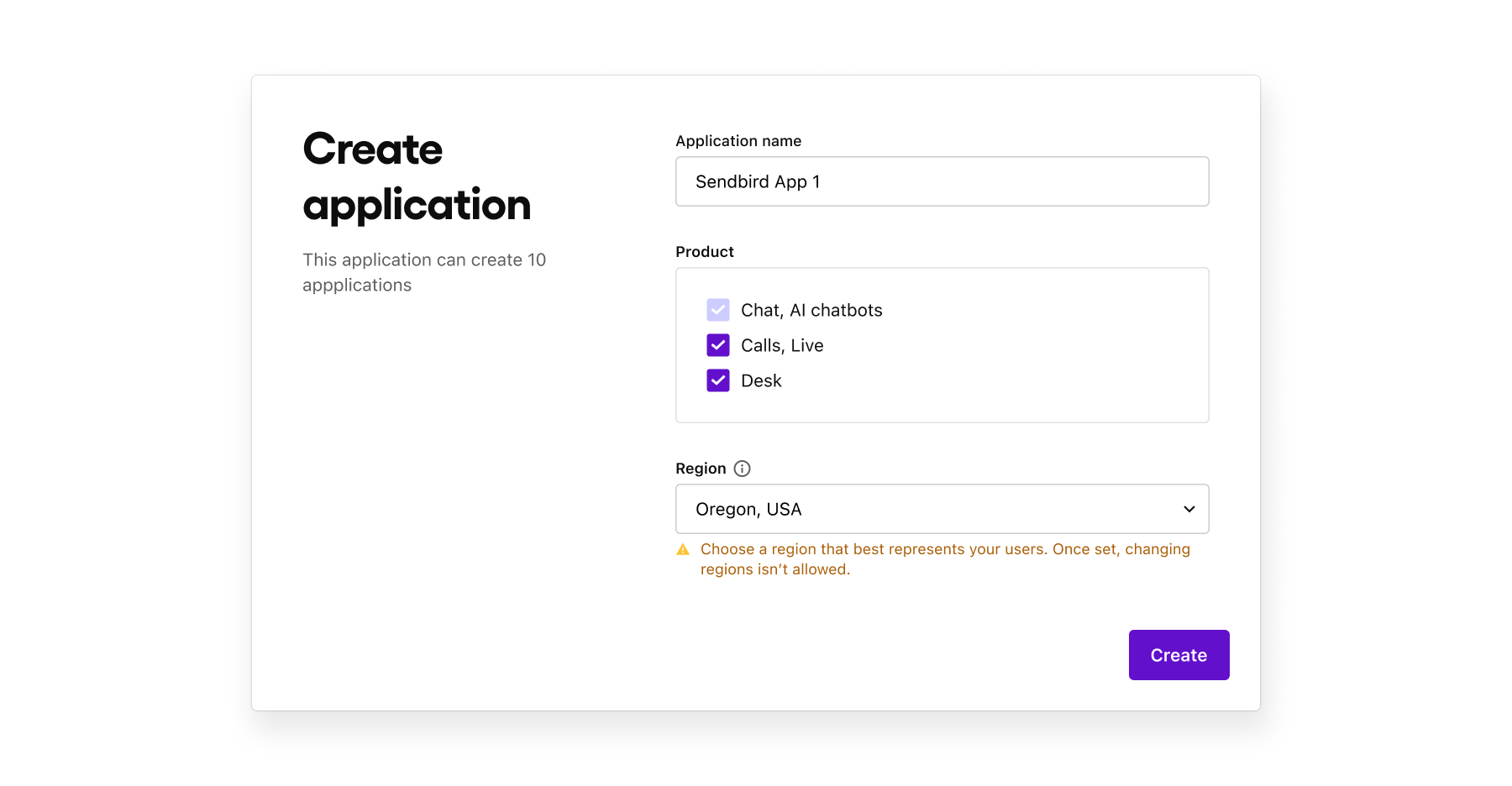
3. Mobile phone
To test Sendbird Business Messaging, we recommend a mobile phone with iOS or Android (or both) that can access data, receive SMS messages, and has an active WhatsApp account.
To test in-app messaging, we recommend preparing a mobile application for testing.
Notification channels setup for customer messaging
The following section guides you on how to set up the various notification channels for customer messaging in Sendbird Business Messaging, including in-app notifications, push notifications, WhatsApp notifications, and SMS notifications.
In-app notifications
In-app messages are centralized within the app, usually through a message center, and can be quickly accessed using a shortcut like a bell icon.
The notification message center allows users to conveniently check and engage with saved notifications. By offering contextual and customizable communication, in-app notifications create a superior business messaging experience for customers that boosts open rates (engagement), CTR (conversion), and satisfaction (retention). You will see later how to implement a notification center into your app.

In-app notifications configuration steps
1. In the Sendbird Dashboard, go to Business Messaging > Channels and click the [Create channel+] button at the top-right corner of your screen.
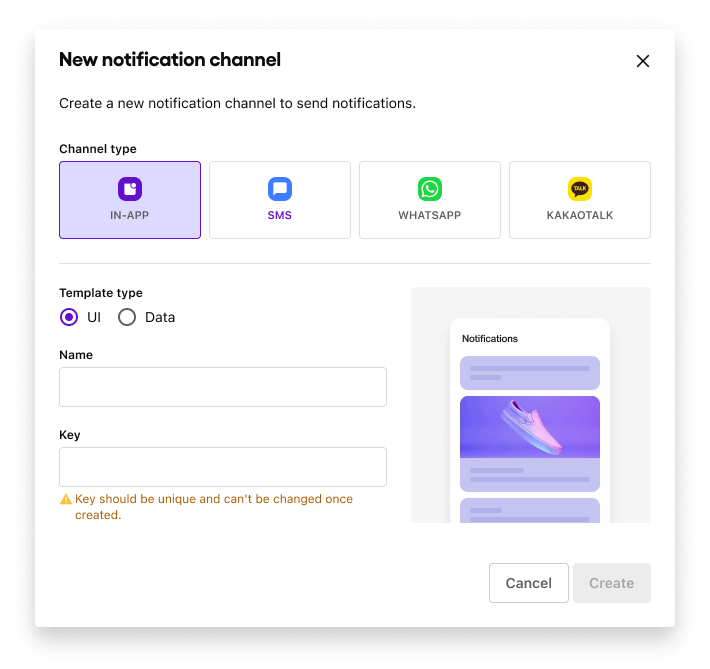
2. Depending on your client app notification center’s implementation, choose “UI” or “Data type” for the template.
UI: select when implementing using the Sendbird in-app notifications UIKit
Data: select when implementing using the Sendbird in-app notifications SDK
Note: Sendbird’s UIKit is a set of pre-built UI components that allow you to integrate a notification center into your app with one line of code. Sendbird’s SDK allows developers to build a full custom notification center to meet even the strictest brand guidelines. The notification center UIKits and SDKs are available for iOS, Android, JS, and Flutter.
3. Fill in the remaining required fields.
Name: the name of the channel (e.g. message center)
Key: the key of the channel (e.g. message center)
4. Click [Create].
Mobile push notifications
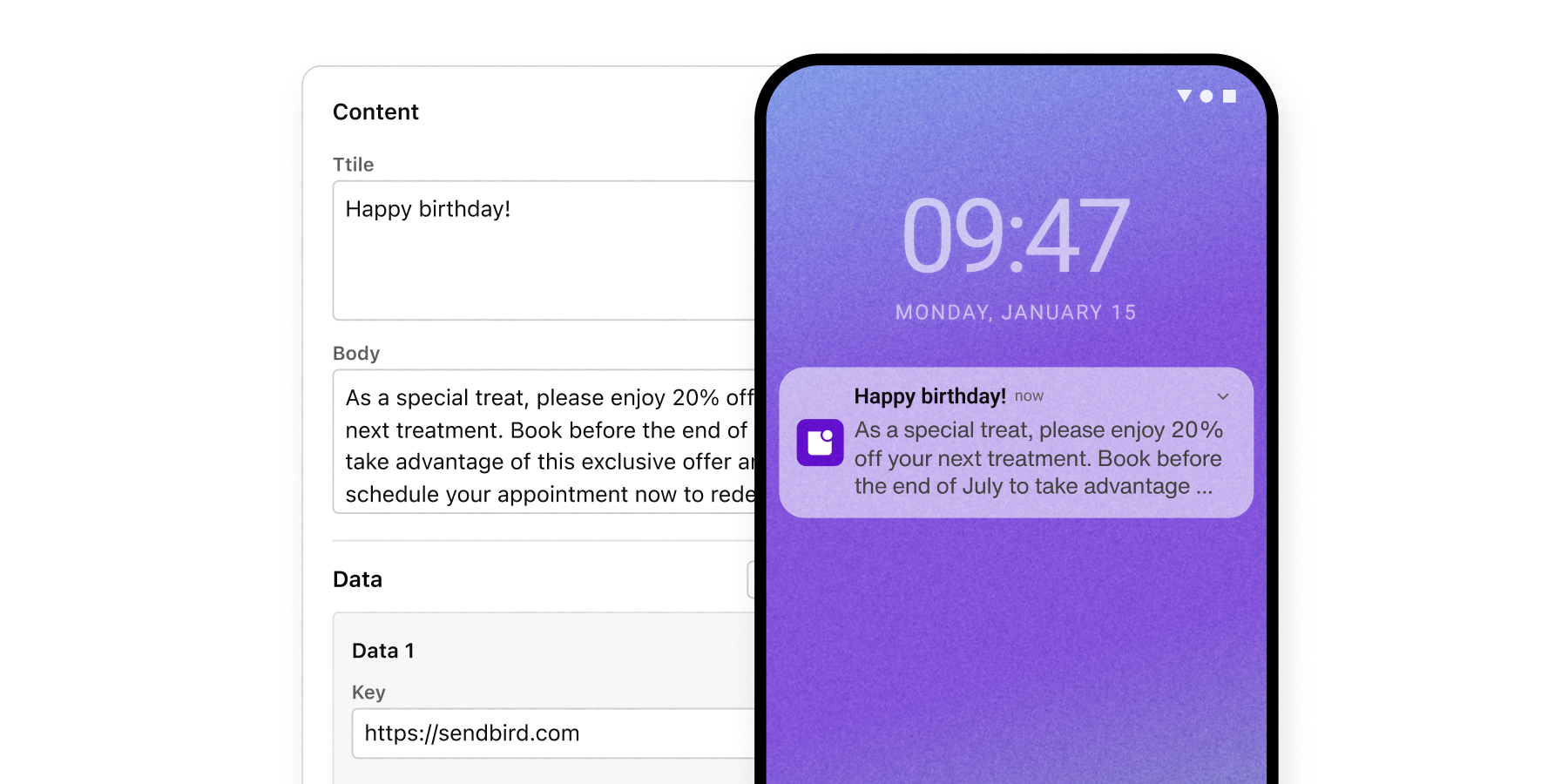
A mobile push notification is a brief, application-to-person (A2P) automated message sent directly to a user's device from an app or service, even when the app isn't actively in use. It’s displayed in the OS's notification center.
Push notifications are non-permanent messages that convey various information types, such as new messages, updates, alerts, or promotional offers.
To send mobile push notifications with Sendbird Business Messaging, you must first register the push service certificates for iOS, Android, or Harmony. To set up the push notification environment within your client app, please refer to the Sendbird push notification documentation.
Consider these additional push notification resources from Sendbird:
Mobile push notifications prerequisites
Firebase Cloud Messaging (FCM) certificate
Apple Push Notification Service (APNS) certificate
Mobile push notifications configuration steps
Please follow the instructions detailed in the Sendbird docs to implement push notifications for iOS and Android.
WhatsApp notifications
To enable WhatsApp, Sendbird must manually turn on a feature flag. Please send your account executive or manager the Sendbird application ID(s) you want to test and use with WhatsApp.
WhatsApp notification prerequisites
- A Meta (Facebook) business account associated with your business
A personal Facebook account for Meta Business Manager
Company’s legal name
Company’s display name
Company’s business website URL
Business email address
- Access to the administrator phone number for your WhatsApp business channel.
If your business does not have a phone number, please contact Sendbird to set up a new phone number.
If your business already has a phone number registered to a WhatsApp Business account, you must transfer your phone number to Sendbird’s Vonage account. Please contact Sendbird to set this up
WhatsApp notification configuration steps
1. Create a WhatsApp notification channel
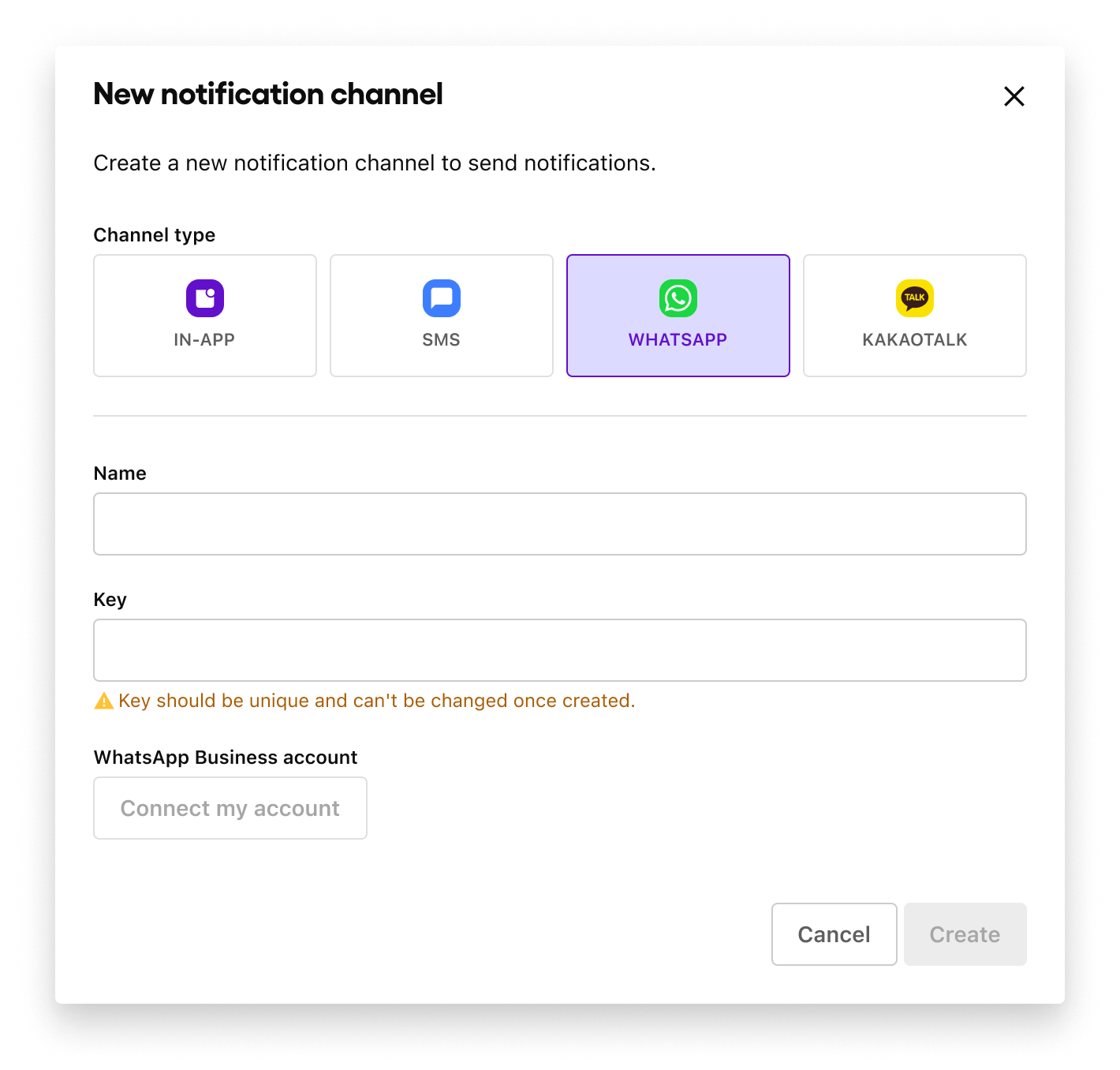
Go to Business Messaging > Channels and click [Create channel+].
Select WhatsApp under Channel type.
Complete all required fields.
Name: Specify the name of the channel.
Key: Specify the channel's unique identifier.
- Click [Connect my account].
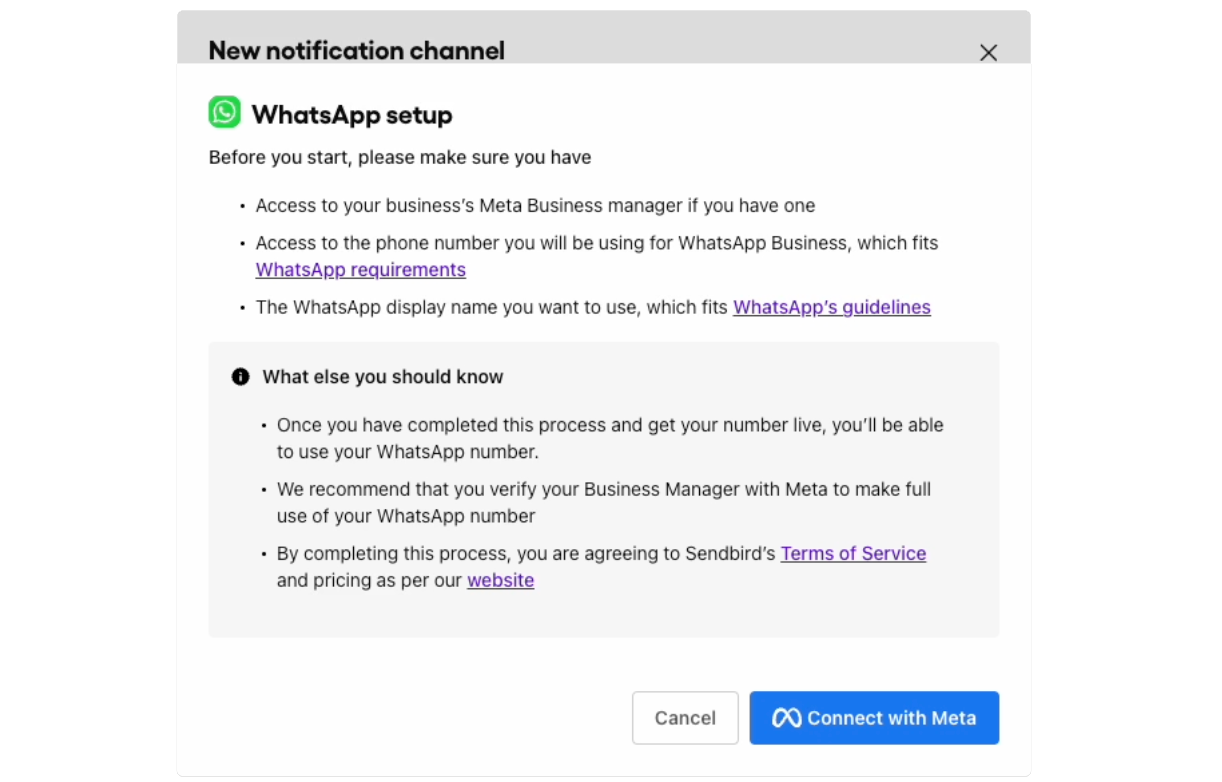
Click [Connect with Meta] after reading the requirements for connecting with Meta.
2. Connect to Meta Business accounts and WhatsApp Business accounts
- Log in to your Meta account and click [Agree and Continue].
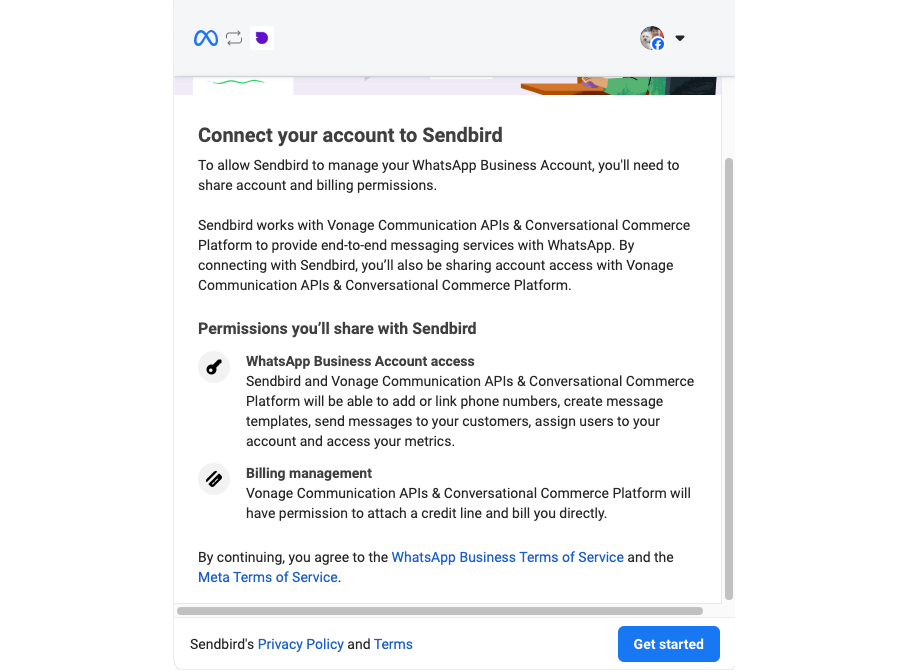
- Meta will show which permissions are shared with Sendbird. Click [Get Started].
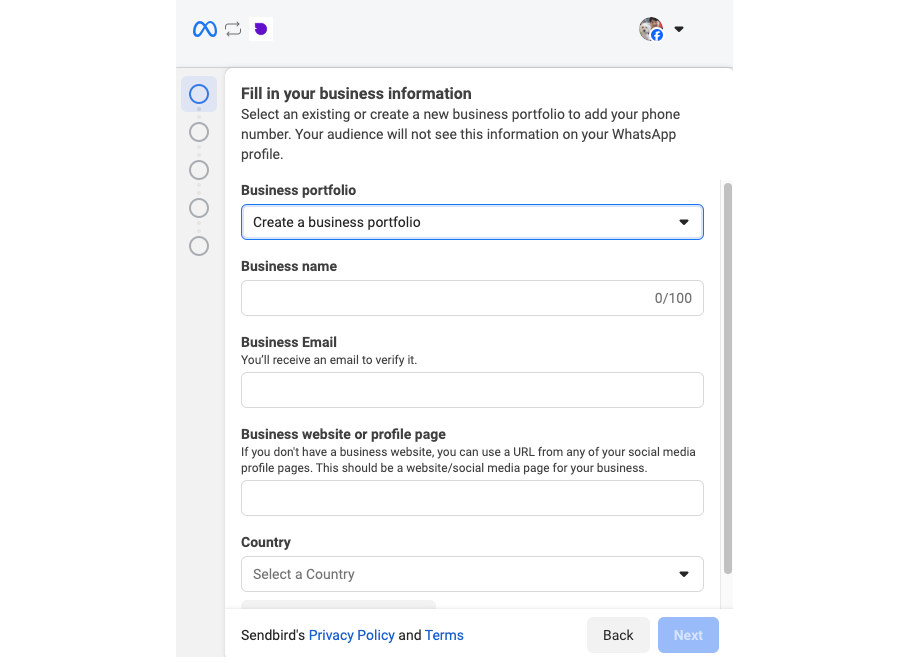
- Create or connect a Meta Business portfolio. For more information, see the WhatsApp Business API.
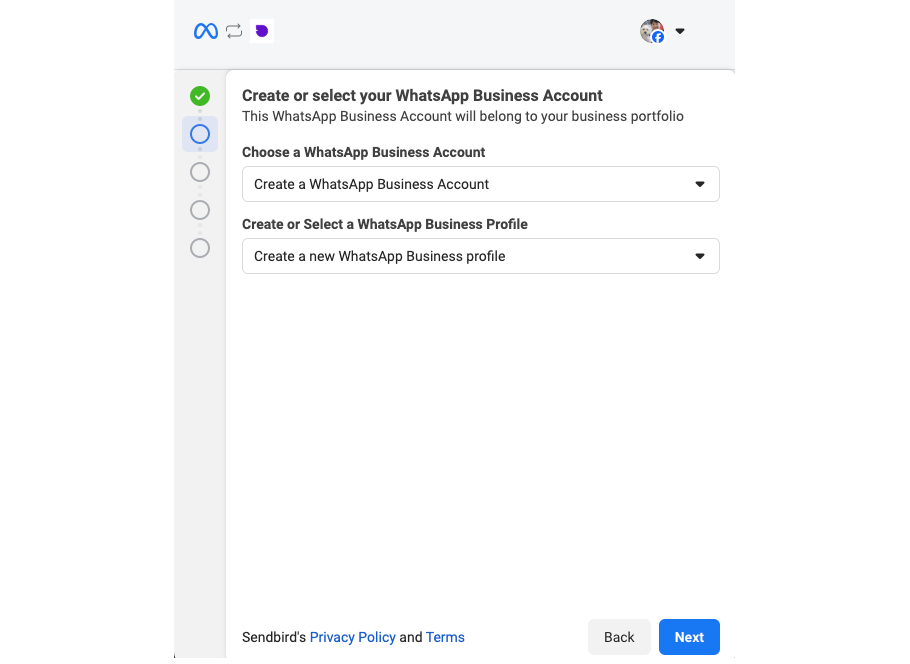
- Create a new WhatsApp Business account and create a WhatsApp Business profile to be shown to your customers.
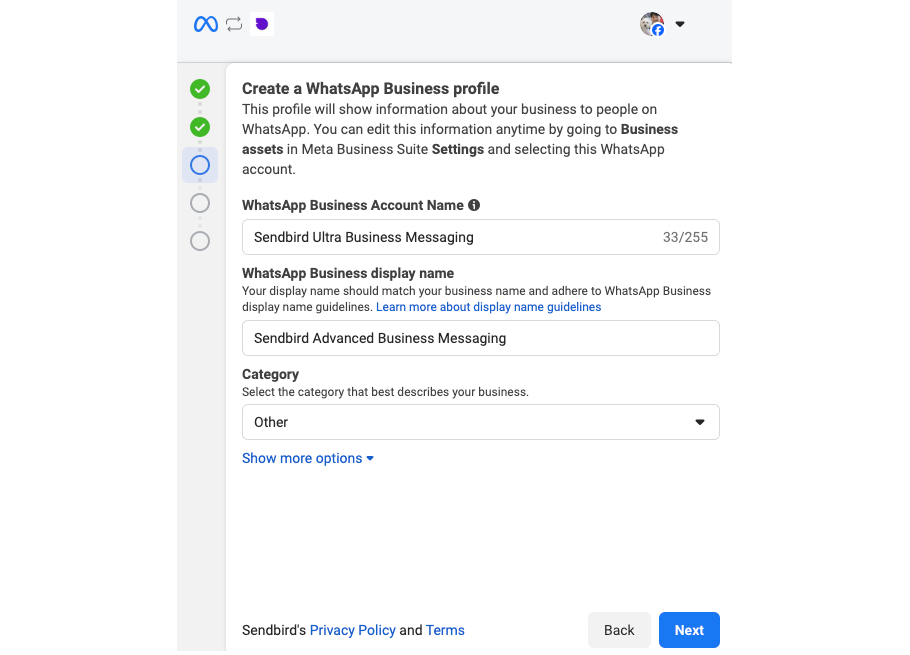
- Next, specify the name of the Whatsapp Business account, the WhatsApp Business display name and specify the category of business. Then click [Next].
Once you click [Next], Meta will validate the Business Account’s name and display name.
3. Add a phone number for WhatsApp
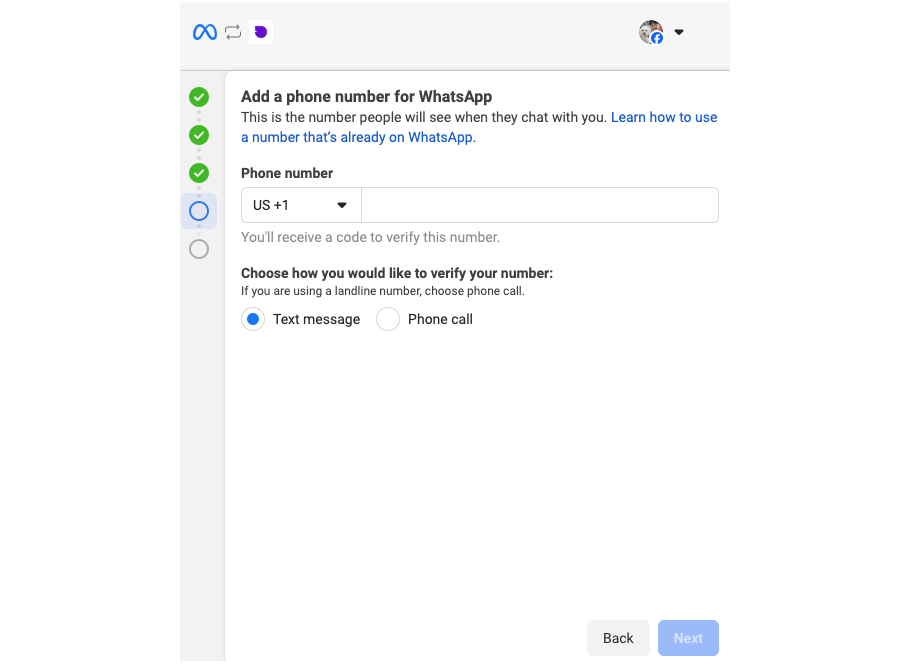
- To connect a phone number with your WhatsApp Business account, you must have access to a phone number to send WhatsApp messages with.
Sendbird will assist you with purchasing a phone number to register to your WhatsApp Business account.
Click [Next] to receive a one time password.
A Sendbird product manager will assist you with providing you the OTP once the message has been sent.
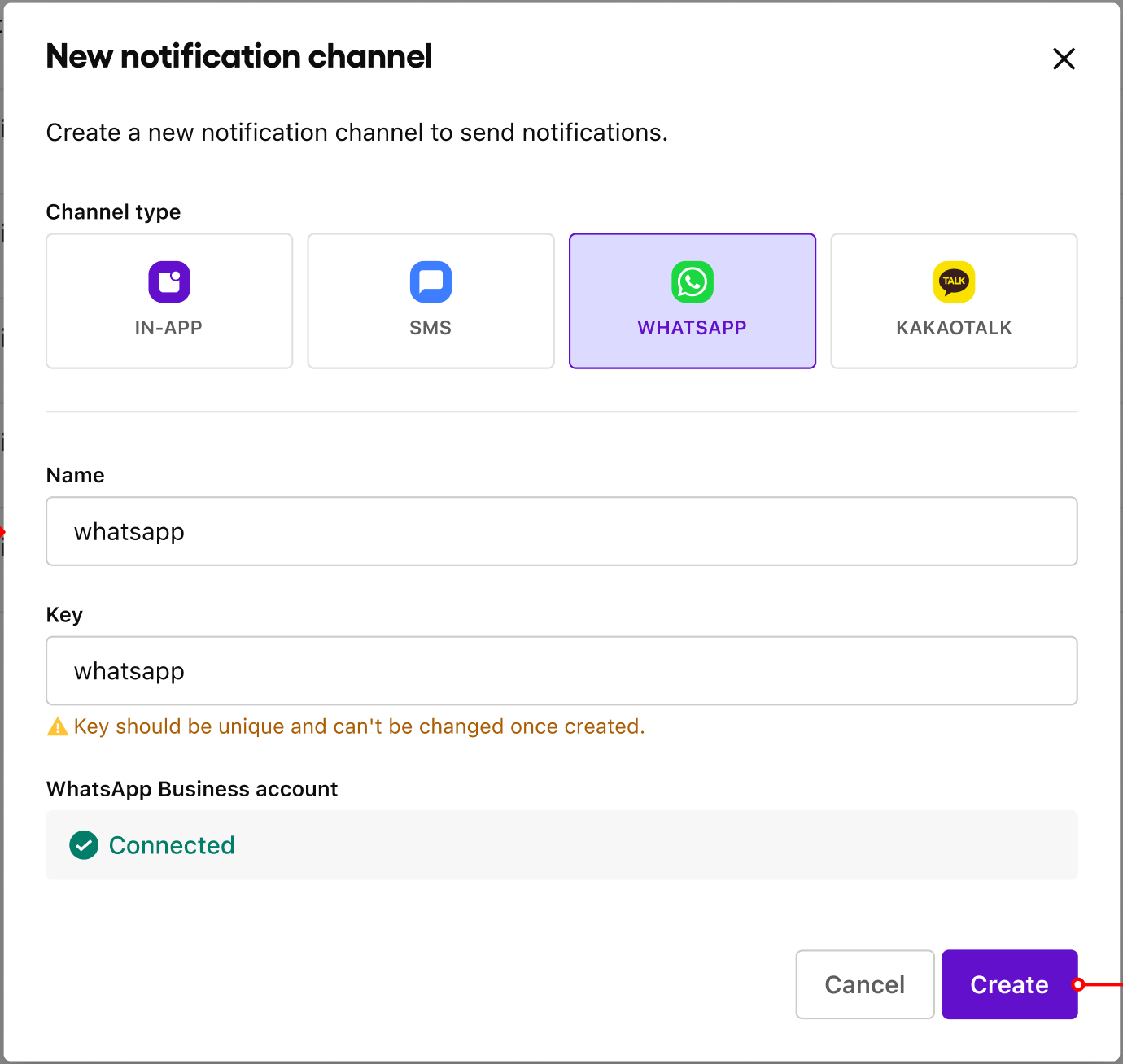
Figure 12: Entering a one-time password for a WhatsApp Business account Once the phone number verification has been completed, click [Create].
SMS notifications
To send SMS using South Korean phone numbers, you must register the sender phone numbers with Sendbird in advance. Please send the prerequisite documents below to your Sendbird account executive or manager. Your account executive or manager will provide you with the templates for the following documents.
Note: Once we have received the documents, please give us 5 business days to complete the setup process.
SMS notifications required documents
Business registration certificate
Proof of telecommunication service use
Service usage agreement
Document confirming the relationship between the business and a third party
Once Sendbird completes the registration process, you can add the registered phone numbers to your organization by accessing the Phone Number menu in the organization sidebar.
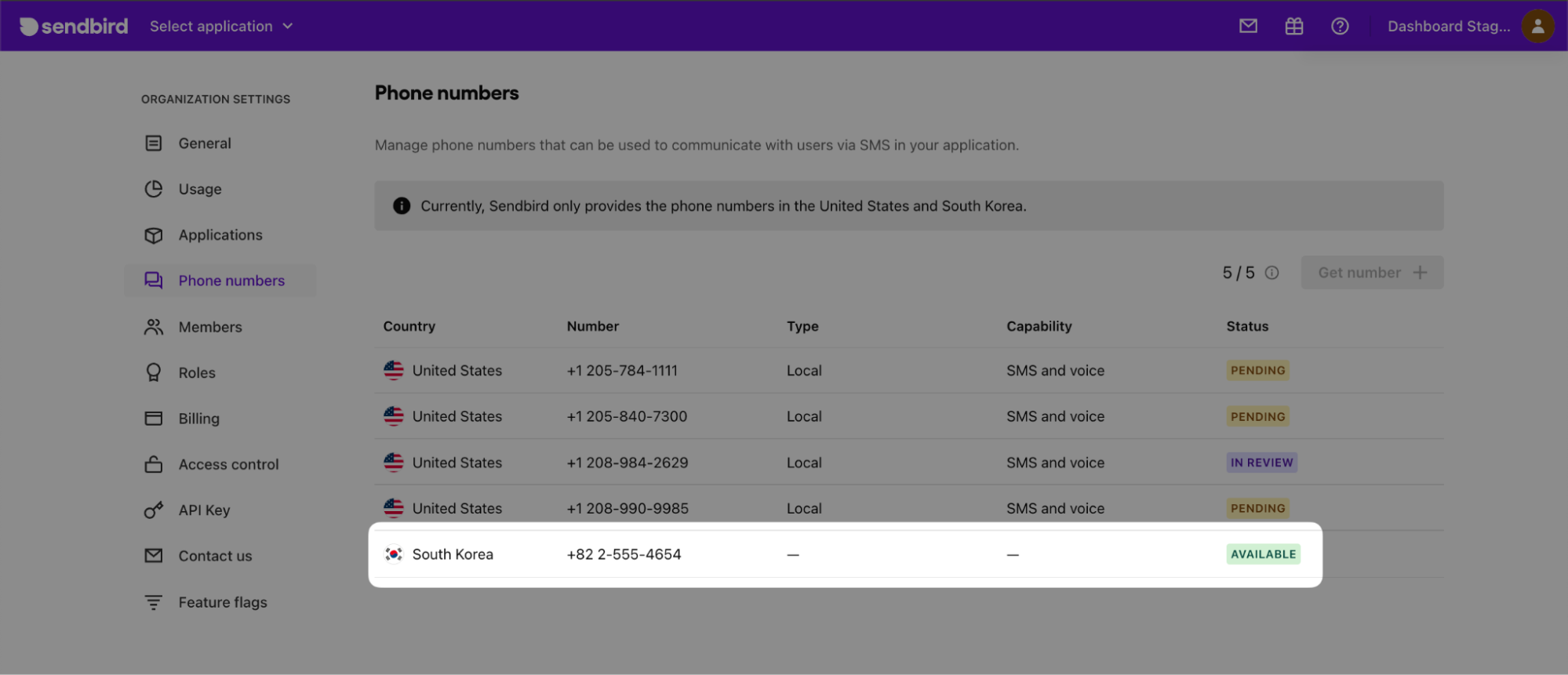
SMS notifications configuration steps
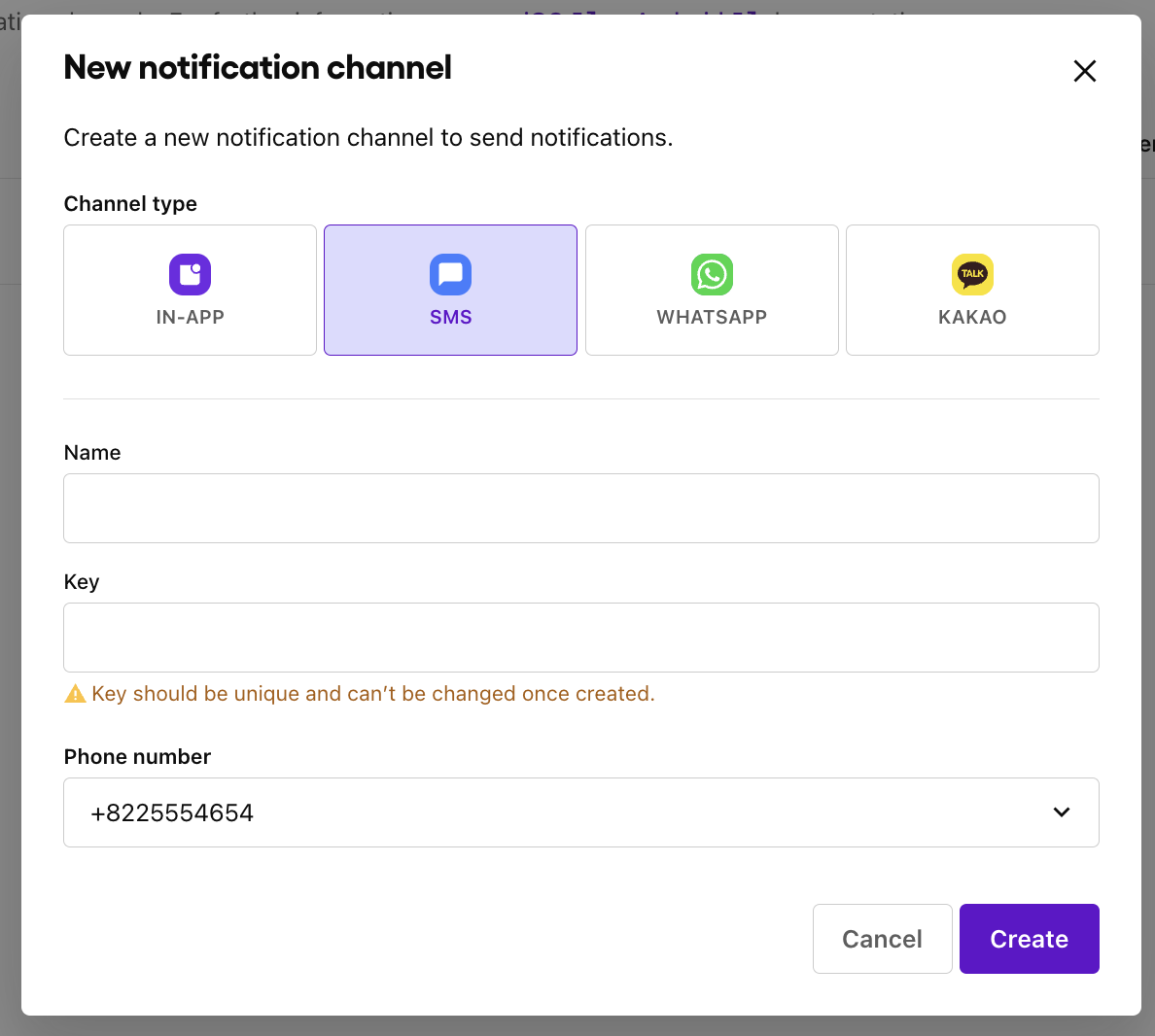
1. Go to Business Messaging > Channels and click the [Create channel+] button.
2. Select SMS under Channel type.
3. Select the registered phone number.
4. Fill in the remaining fields required.
Name: the name of the channel (e.g. SMS - Transactions)
Key: the key of the channel (e.g. sms-transactions)
5. Click [Create].
Campaign/outreach notification templates for customer messaging
Once all channels are added, the next step to use Sendbird Business Messaging is to learn how to create and use campaign/outreach templates.
Templates are an integral part of Sendbird’s Business Messaging platform and are currently the only way to send customer notifications. They are omnichannel, meaning a single template can contain multiple channels (e.g., in-app, push notifications, SMS, WhatsApp) and sequencing conditions for optimized delivery.
Sendbird simplifies omnichannel messaging with a unified API and messaging templates
Rather than directly sending a notification to the user with the user’s phone number and push device token, like when using Twilio SMS APIs — Sendbird requires a user to be created in advance.
Next, the user’s phone number and push device token should be added to the user profile. Then, sending a notification requires a user ID and a template to target the user on the right channel.
Sendbird omnichannel customer messaging API vs. legacy communication API
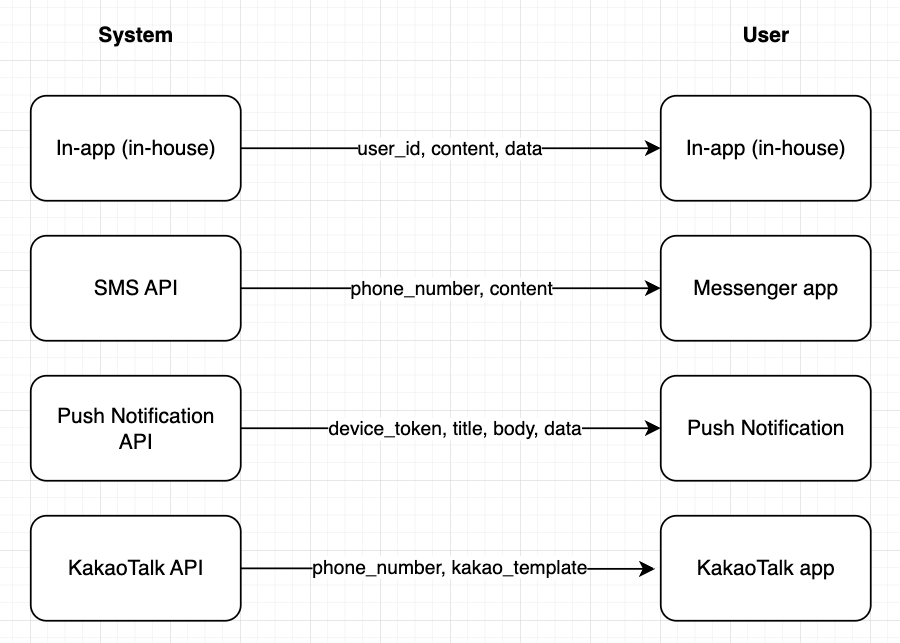
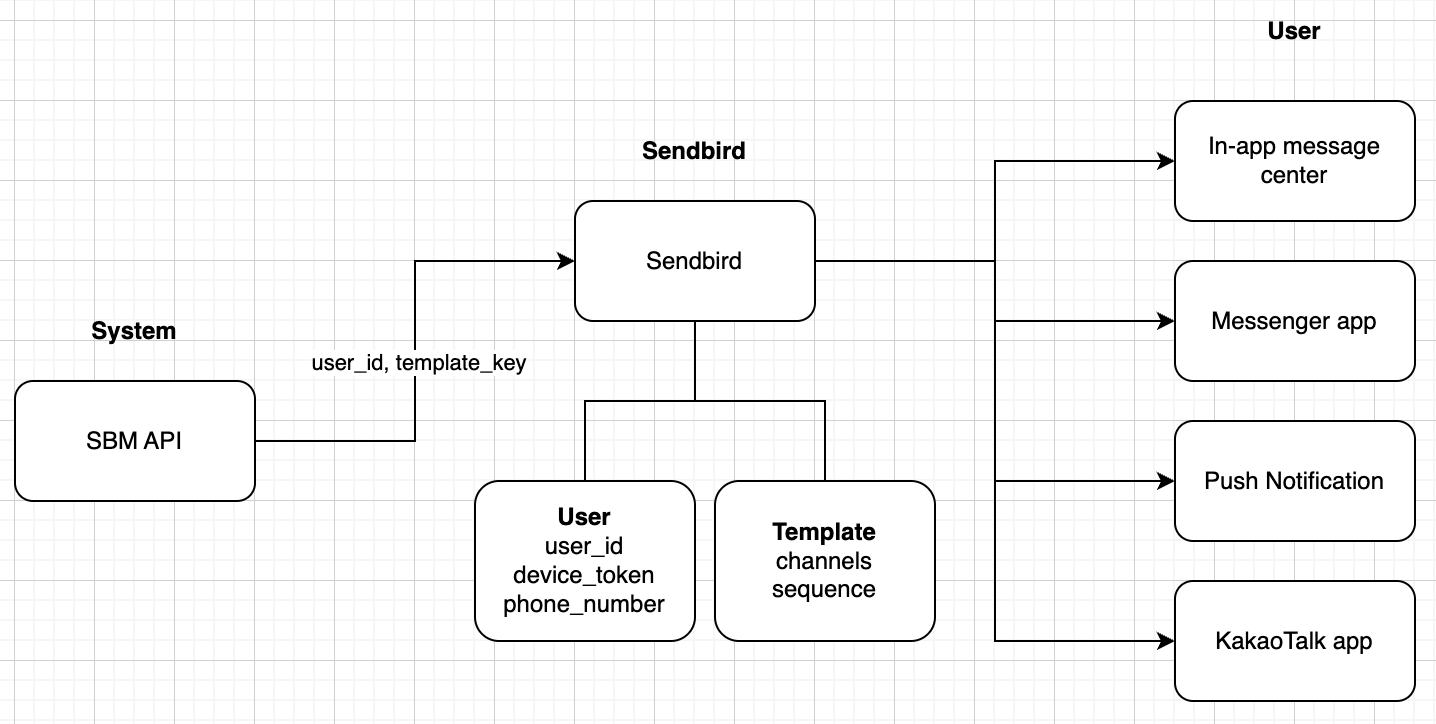
🎉The advantage of this abstraction is that we can provide user insights (user-level data), as we have merged everything through the Sendbird user profile.
Additionally, omnichannel templates allow for easy modification of a notification's content, channels, and delivery sequence.
Note: You can create a template with a single channel (e.g. WhatsApp).
Notification template global variables
Sendbird Business Messaging uses global variables, where a single set of variables within a single template are shared across the multiple channels added to the template. For example, a variable called name can be used seamlessly across in-app, push notifications, SMS, and WhatsApp.
The variables are provided to the channels when sending a message through the API or the Sendbird dashboard.
Notification template configuration steps
1. Create a campaign/outreach notification template
Go to Business Messaging > Templates and click the [Create template +] button.

2. Campaign/outreach notification template information
Enter a notification campaign/outreach template name and key.
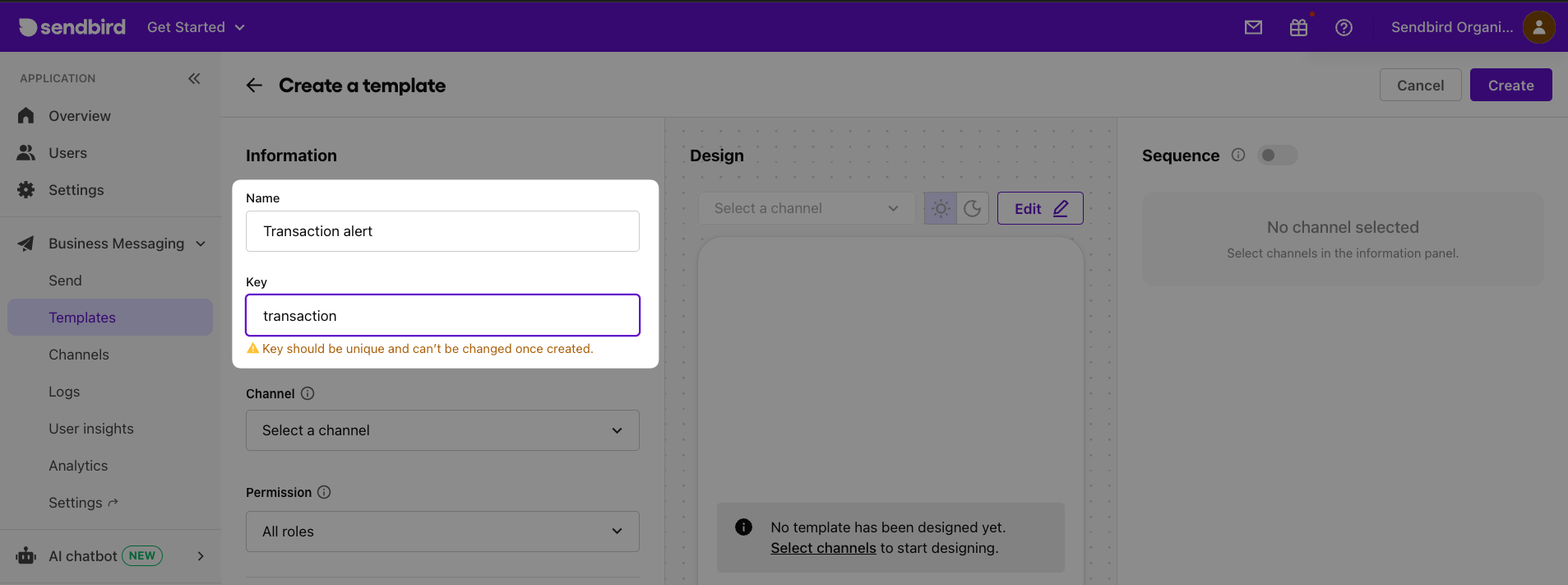
Template name: plain text used to denote the template (e.g. transaction alert)
Template key: used when sending notifications through the API or dashboard
3. Template notification channel selection
Select the notification channels to be added.
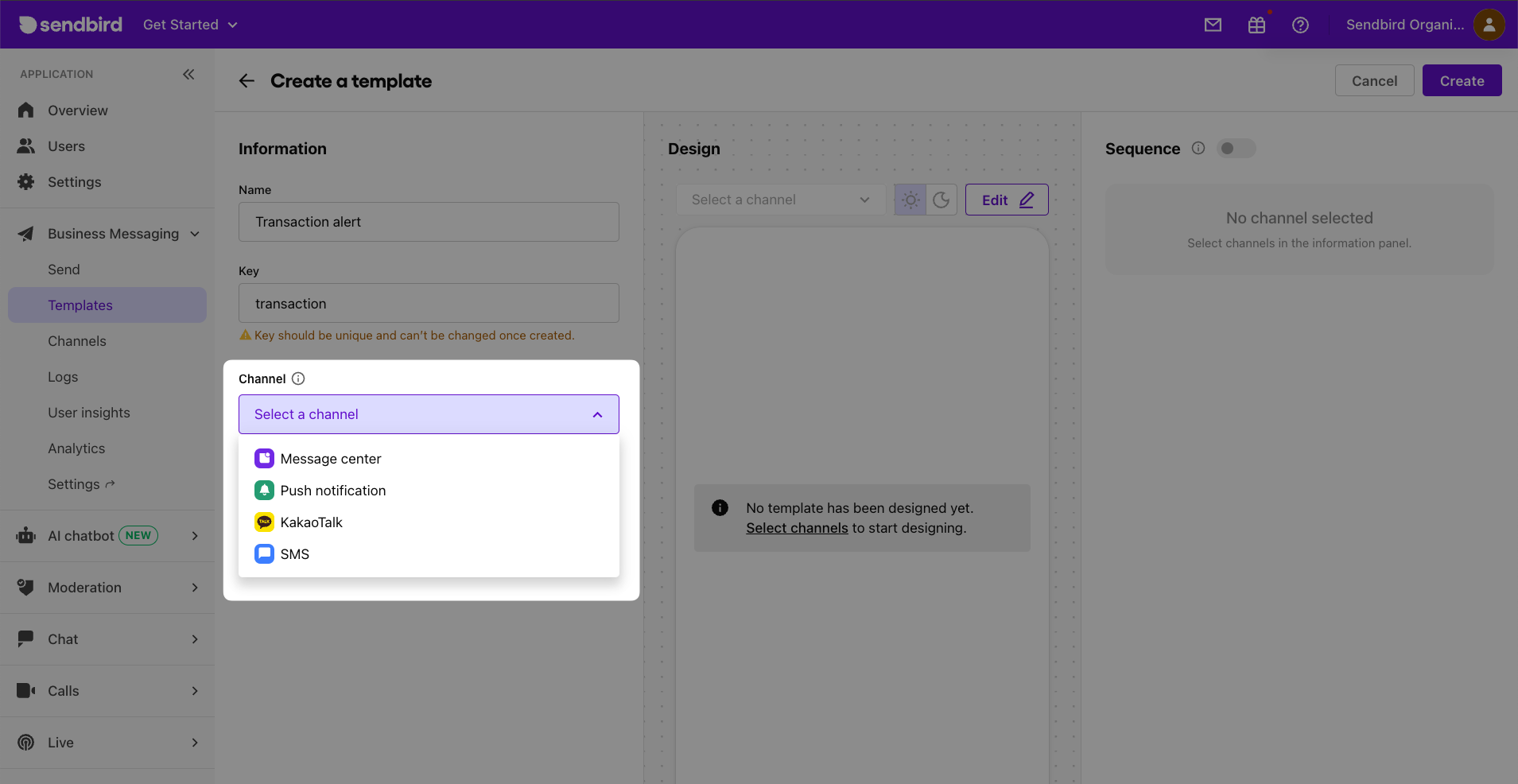
Note: you must complete the Channel Setup section before creating a template.
4. Campaign/outreach message creation
Once you select a set of channel types to link to the template, you can edit each channel's message layout and content using the message builder/editor.
In-app notification message creation
UIKit/UI template type: You can customize each template element, such as padding, font size, color, alignment, etc. The global theme will control some aspects of the template design.
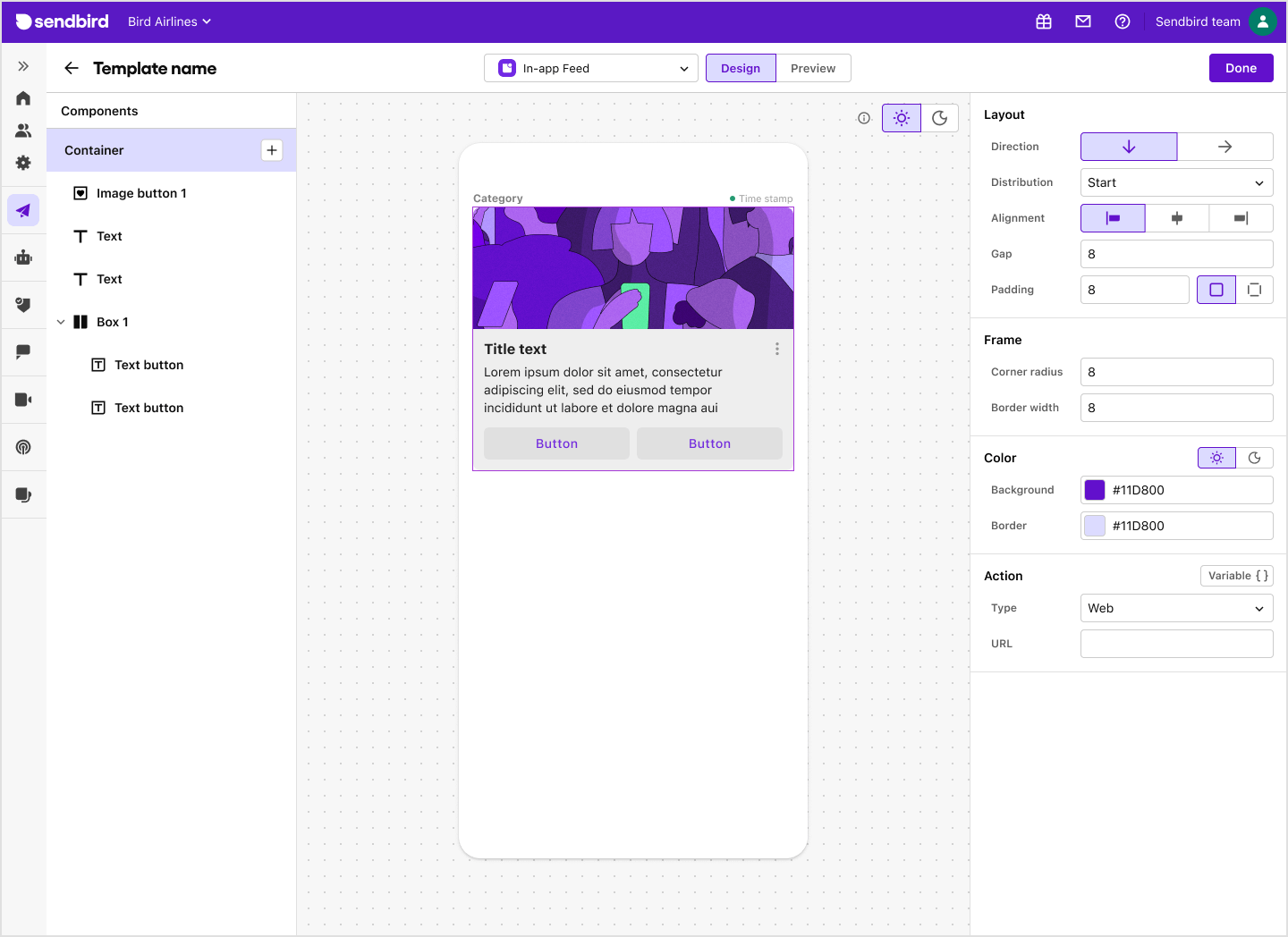
Figure 20: Customizing the in-app notification of a messaging campaign SDK/data template type: When using the in-app message center SDK, the message editor allows you to customize the title, body, variables, etc. When using the in-app message center SDK, the UI/UX is up to you to develop.
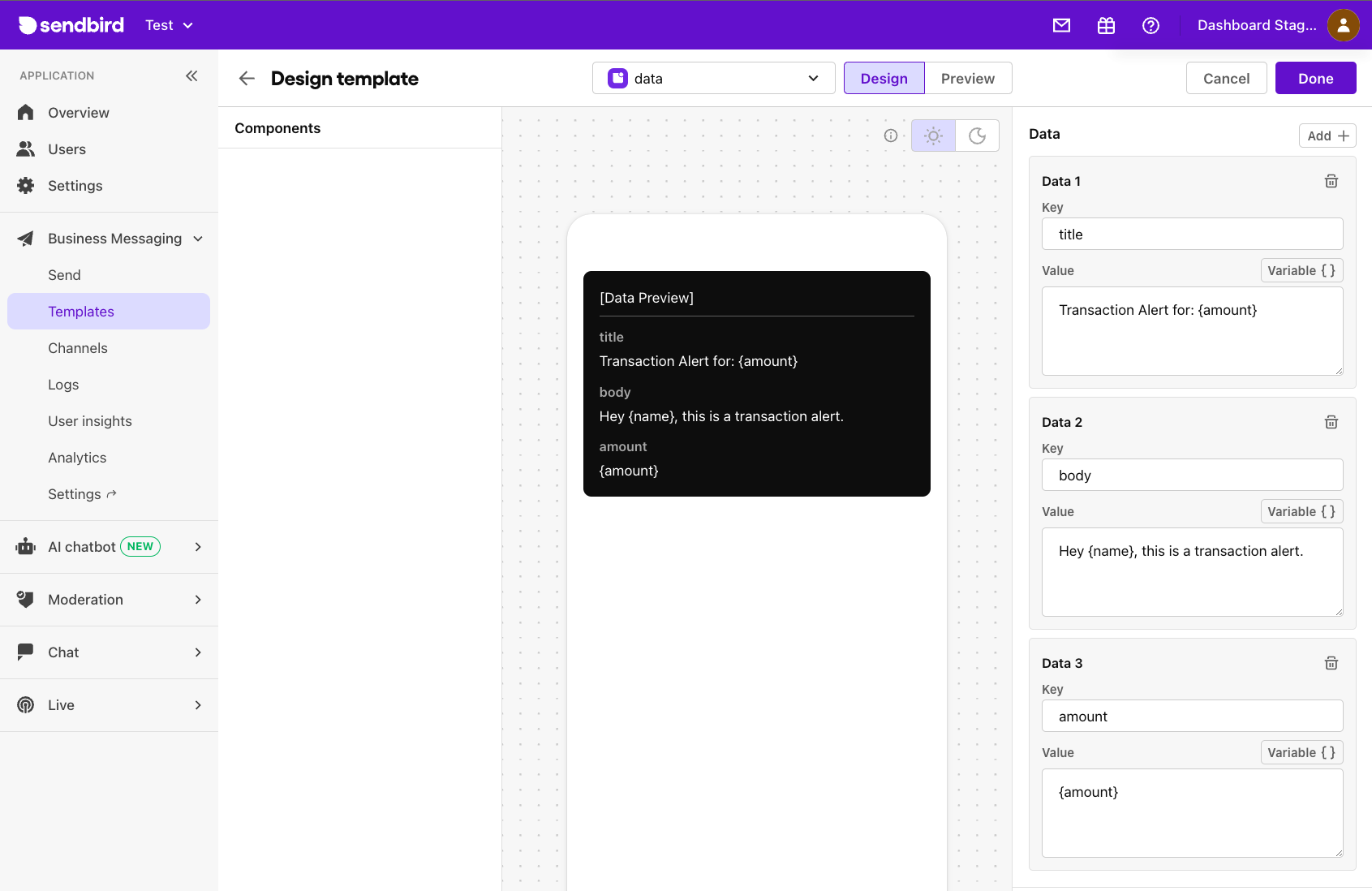
Figure 21: Customizing data for an in-app notification in the Sendbird Business Messaging dashboard when using the in-app message center SDK
- Push notification message creation
- Title: the title of the push notification
- Body: the body of the push notification
- Data: custom data sent for uses such as deep links (path), transaction_id, event_id, etc.)
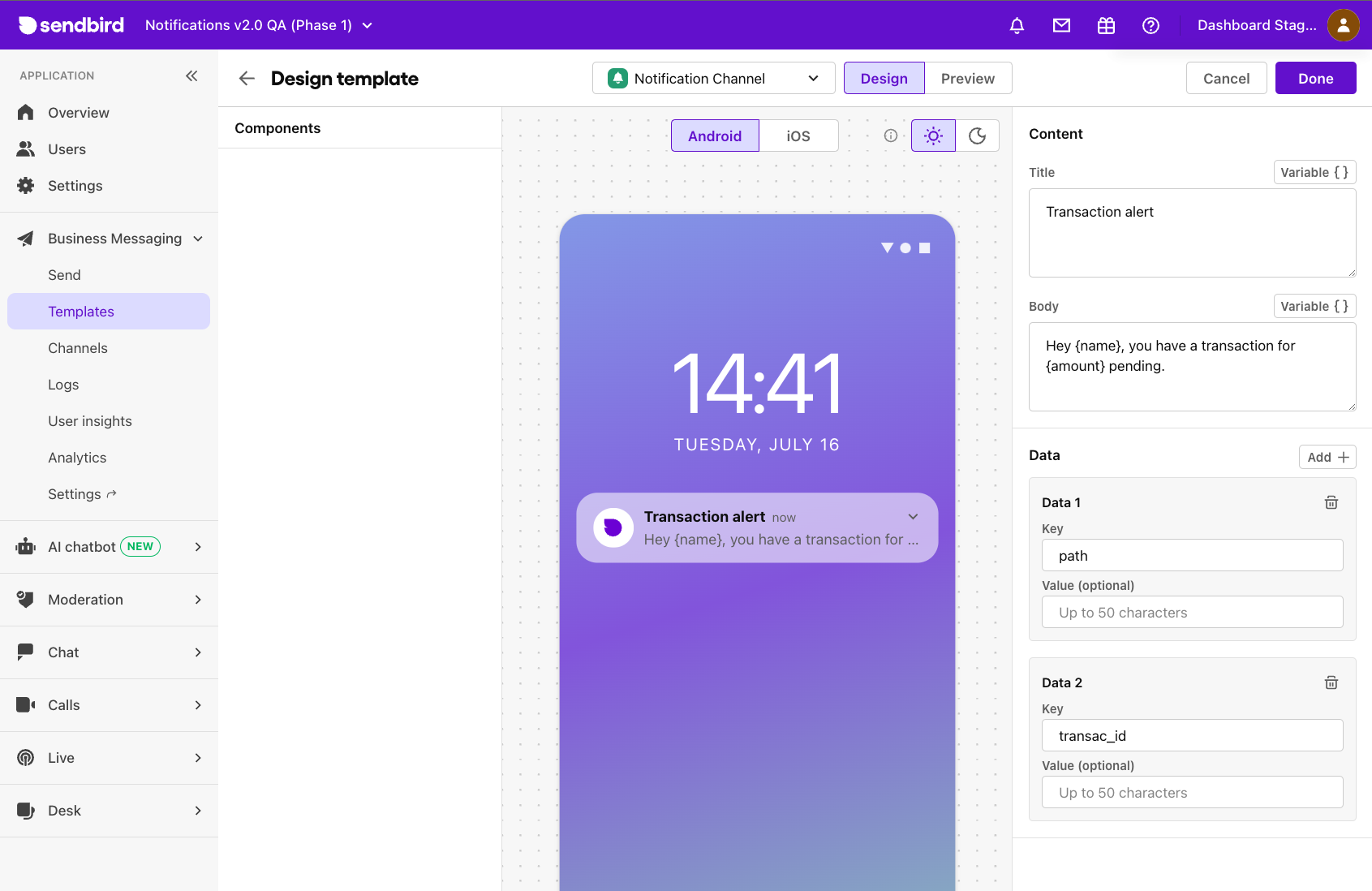
Figure 22: Customizing a push notification for a messaging campaign/outreach in the Sendbird Business Messaging dashboard
- WhatsApp notification message creation
- Header: the title of the WhatsApp notification
- Body: the content of the WhatsApp notification
- Footer: optional text for closing the message
- Buttons: Options for quick reply, call number, or links
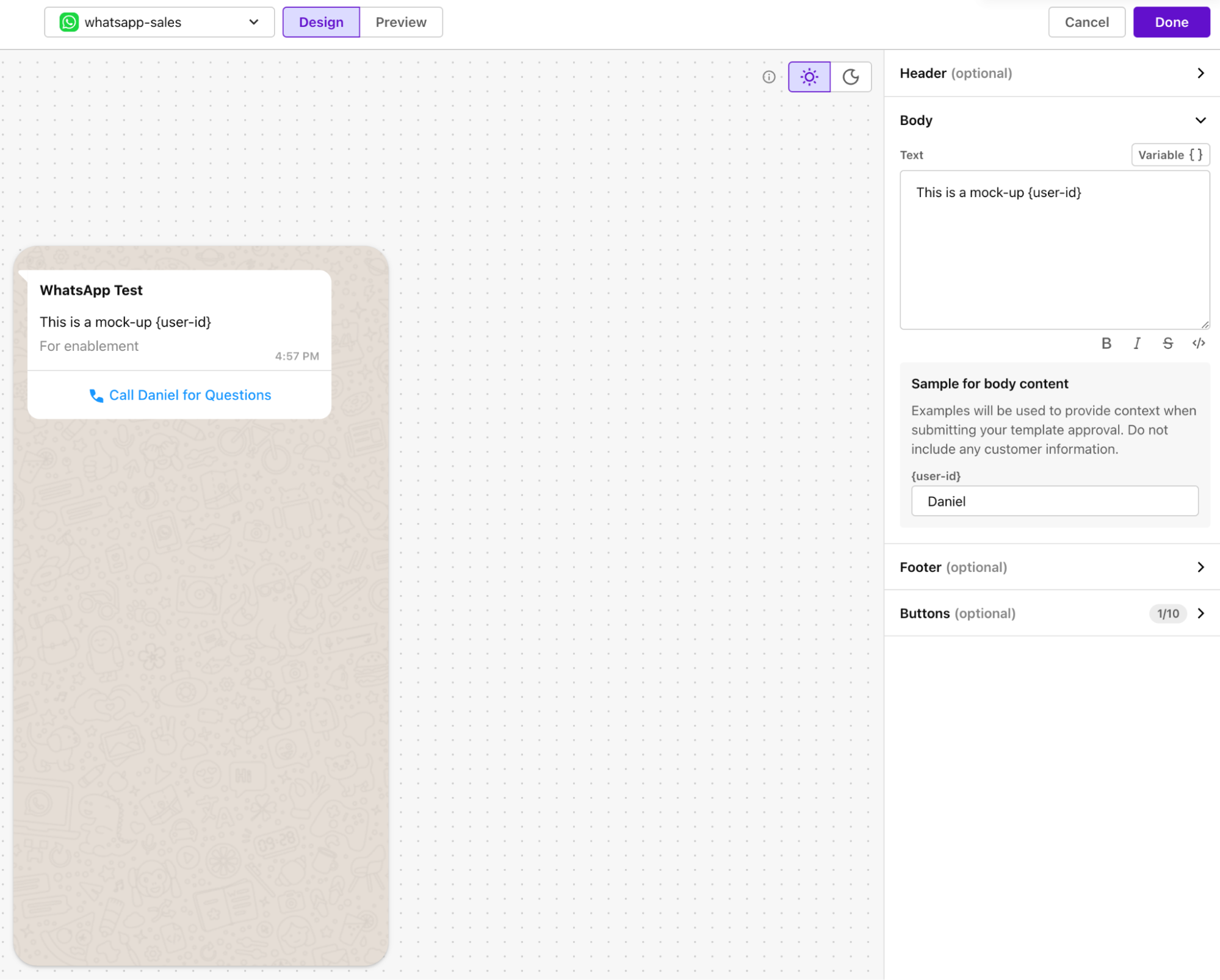
Figure 23: Creating a WhatsApp notification for messaging campaign/outreach in the Sendbird Business Messaging dashboard
- SMS notification message creation
- Content: the body of the SMS notification
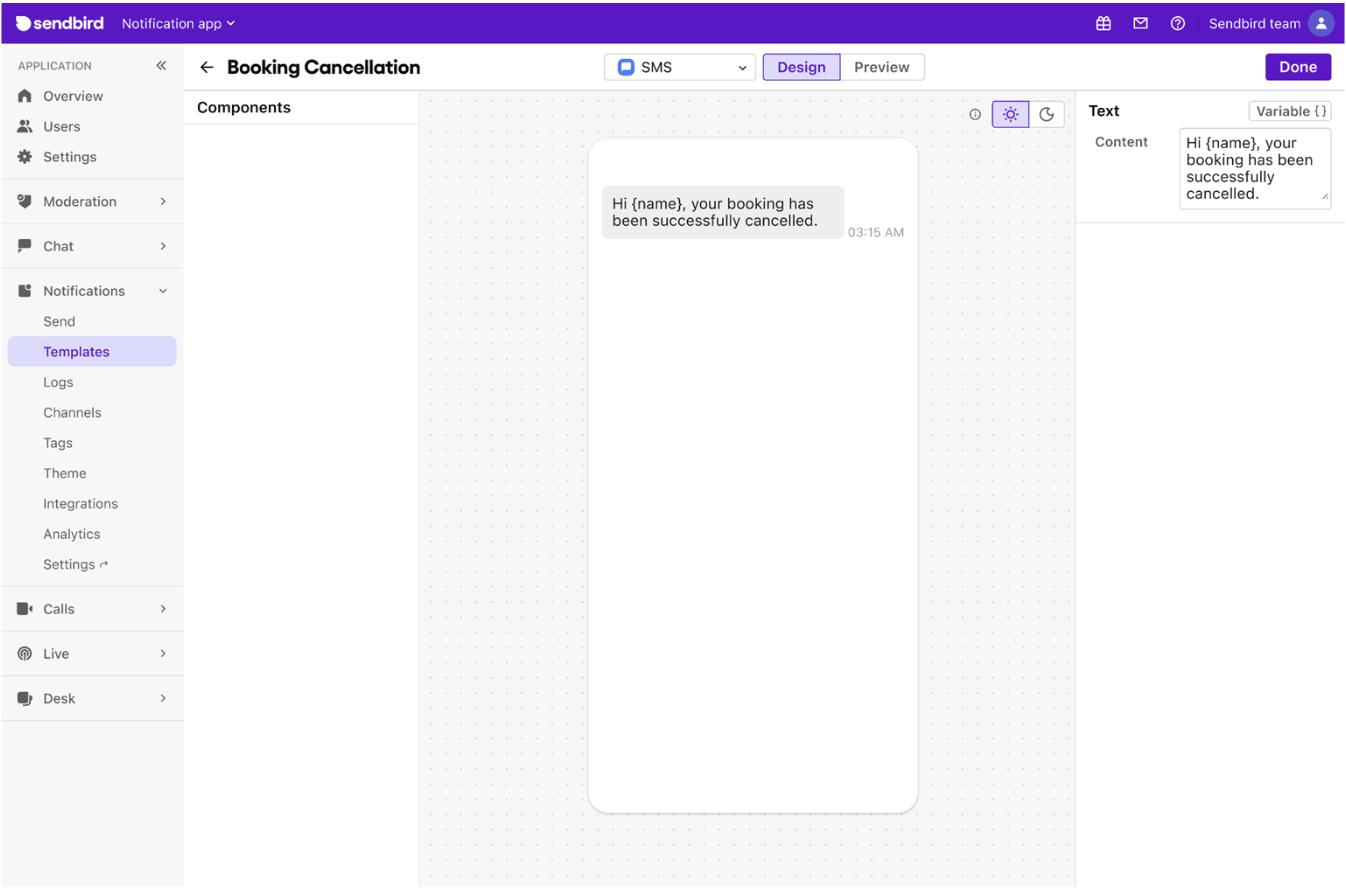
Figure 24: Customizing an SMS notification for a customer messaging campaign/outreach in the Sendbird business messaging dashboard
- Content: the body of the SMS notification
5. Creating a mobile notification channel delivery sequence
Once the channels and content are set, the next step is configuring a sequence.
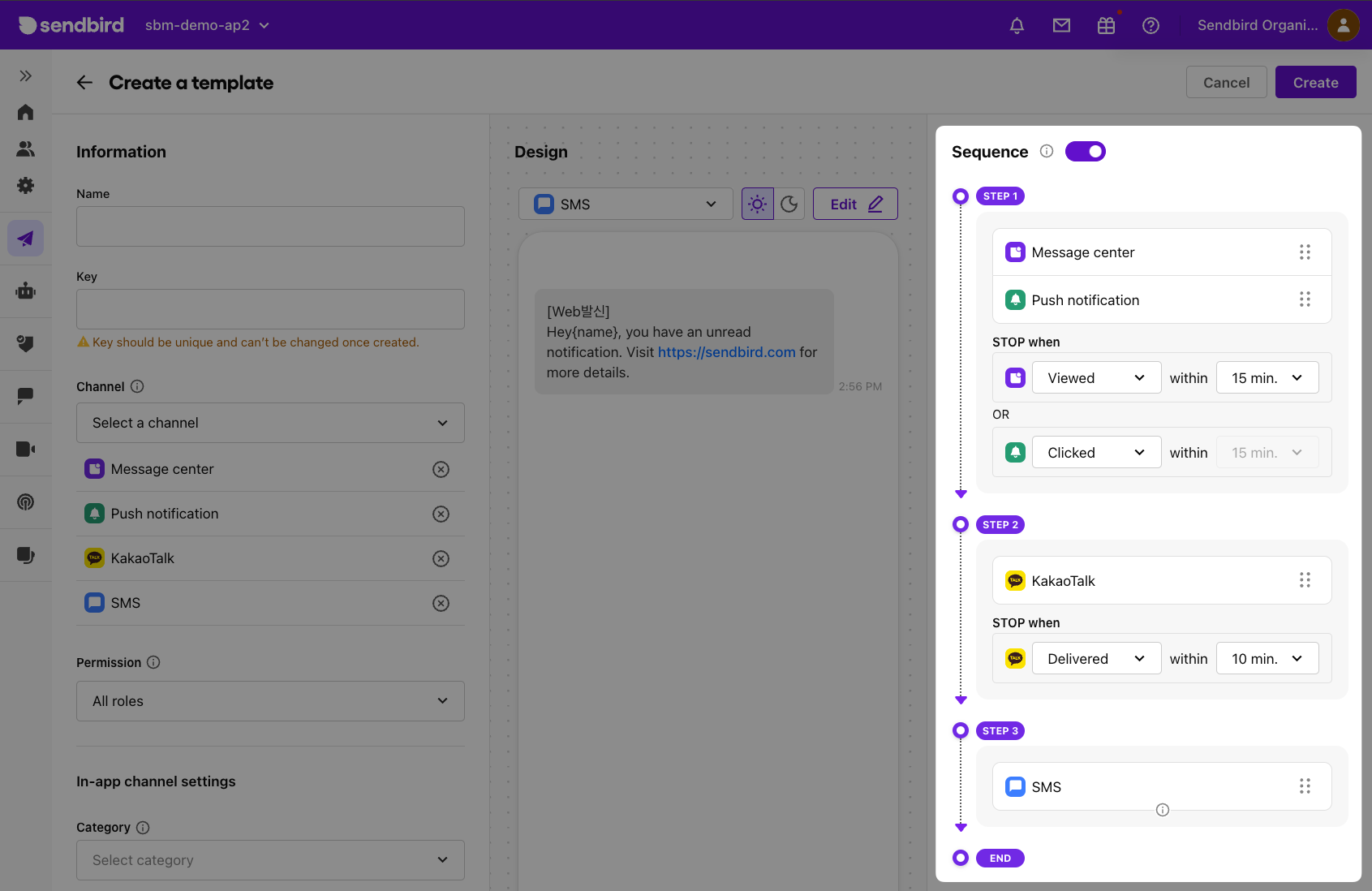
What is a mobile notification channel sequence?
A mobile notification channel sequence is a predefined order in which notifications are delivered across multiple channels. The steps have conditions and time delays, which a user can configure on the fly without any engineering resources.
Recommended usage: Send to the most economical channels (in-app + push) together as Step 1, WhatsApp as Step 2, and SMS as Step 3. Depending on the urgency, the condition can be changed, but we recommend starting with in-app and push notifications for insights (viewed and clicks) and cost efficiency.
Note: For SDK implementation - please ensure your SDK implementation is correct for in-app view/click conditions to work correctly.
- Mobile notification metrics and observability by channel:

- In-app notifications:
- Delivered: when an in-app message is sent to the user
- Viewed: when a user views an in-app message
- SDK: implement view logic through the provided method
- UIKit: automatically tracked when a message is rendered 0.5 seconds on the screen
- Clicked: when a user clicks on a button within an in-app message
SDK: implement click logic through the provided method
UIKit: automatically tracked when a user clicks on a button
- Mobile push notifications:
Delivered: when a push notification has been delivered to the user
Clicked: when a user clicks the push notification and opens the app
- WhatsApp notifications:
- Delivered: when a user’s device receives the WhatsApp message
- Clicked: coming soon
- SMS notifications:
Delivered: when a user’s device receives a SMS
Clicked: coming soon
- In-app notifications:
5. Configure permissions and in-app notifications-specific settings (optional)
Permissions: roles that can edit the template
- In-app notification channel settings:
In-app notification categories are used so that an end user may utilize it to filter the list of notifications rendered. This is optional and can be configured per channel. By default, Sendbird Business Messaging creates updates, promotions, and announcements but these can be configured by accessing Business Messaging > Channels > In-app channel > Category filters.
In-app notification labels are used to send metadata that labels each notification. When using the UIKit, the label is automatically rendered in the upper left corner of the notification. In an SDK implementation, feel free to use the label for whatever purpose is necessary.
In-app notification message retention configures the expiration settings for each in-app message. For example, if this is set to 3 days, and a notification is sent using this template, it will expire and be deleted from the user’s in-app message center after 3 days.
6. Click [Create]
Implementing your in-app message/notification center
Implementing an in-app notification center requires deciding between the Sendbird in-app notification SDK or the Sendbird in-app notification UIKit.
Sendbird in-app notification UIKit
Using the Sendbird in-app notification UIKit accelerates speed to market and lessens maintenance, as Sendbird is responsible for storing and rendering the in-app message center.
The UIKit allows complete customization of the message and the message center through features within the Sendbird dashboard.
Note: To utilize the Sendbird in-app notification UIKit, please select a notification UI template type when creating an in-app channel (refer to step 2 of Channel Setup).
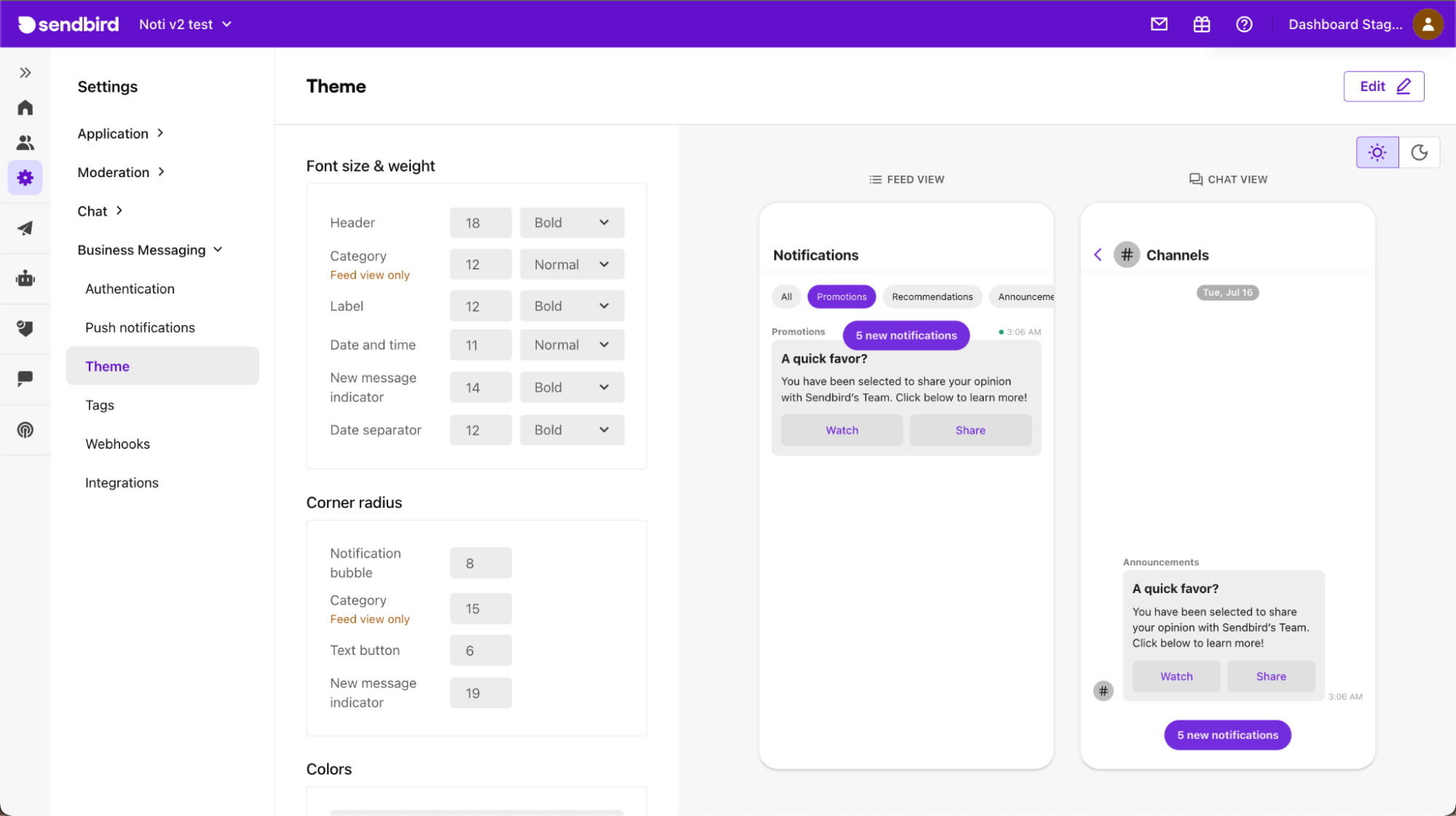
Installation
Sendbird in-app notification SDK
The Sendbird in-app notification SDK offers full customizability without storing the message data on the Sendbird platform. The in-app notification SDK also allows you to pass data using templates and metrics such as in-app views and clicks, sequencing, and analytic features. The tradeoff is time to market.
Note: To utilize the Sendbird in-app notification SDK, please select the Data template type when creating an in-app notification channel (refer to step 4 of Channel Setup).
In-app notification SDK installation instructions by platform
Sending customer notifications via the Sendbird Business Messaging API
Sendbird Business Messaging API use case
The Sendbird Business Messaging API sends messages from external systems, such as your payment, shipping, or logistics tech stack.
Everyday use cases include payment/transaction alerts, account updates, and user event-based marketing messages.
Through the Sendbird business messaging API, you can send mobile notifications in real-time to a single user, or in batches to many users.
Single user: This type of notification targets a single user for immediate delivery. It is ideal for event-based notifications like appointment reminders or transaction confirmations.
- Batch: Designed to send notifications to multiple users, with two methods to send:
Array: Supports up to 10,000 users directly in a JSON array.
CSV: For more than 10,000 users, up to 100,000, use a CSV file.
Sendbird Business Messaging API Implementation
To send notifications, you need to use the Sendbird Platform API. Ensure you have your base URL and API token, which are accessible through your account or API settings here.
To send a notification via the Platform API, make a POST request to the following endpoint:
Unset
POST {base_url}/v2/notifications
To authenticate this request, you’ll need to pass in the following header:
Unset
'Api-Token': '8ww199t0opk2wq1f7uwiqslwip5dhhd5rj3pmkoy' // example token
Required parameters
Name | Type | Description | ||
template | json | Specifies the template used to send the notification. | ||
template.key | string | Specifies the key of the template used to send the notification. | ||
template.variables | json | Specifies the customizable variables in a template. | ||
targets | array of strings | Array of Sendbird user IDs | ||
mode | string | Specifies which mode is used to send the notification, depending on the number of recipients. - - | ||
title | string | Specifies the title used to send the notification. This field can be used as a label to organize and manage individual notifications. |
Optional parameters
Name | Type | Description | ||
template.push_notification_data | json | Specifies the custom data (key/value) within a push notification template (max 5 pairs). | ||
priority | string | Specifies the delivery priority level of a batch notification. Acceptable values are * This is effective only when mode is set to | ||
tag | string | Specifies a key that groups notifications together. This key is used in the Analytics page on Sendbird Dashboard to sort and categorize notifications. |
Real-time
Batch mode
Sending mobile customer notifications via the Sendbird dashboard
Sendbird mobile customer notifications use cases
Sending mobile notifications through the Sendbird dashboard can be helpful when operators want to send direct or bulk messages to a group of users for cases such as announcements, marketing promotions, or any updates to a group of users.
Sendbird mobile customer notifications prerequisites
- User list: If you need a more significant number of users, please contact your Sendbird account manager or executive.
CSV file: the default limit is 100,000 users in a single batch.
Input individual users: up to 10,000 users.
Template: Sending notifications requires a template to be created and available.
Sendbird mobile customer notifications steps
Refer to this link for detailed steps on using the dashboard to send omnichannel mobile notifications.
Managing phone numbers for SMS messaging
To send notifications through SMS or WhatsApp, you must register users' phone numbers on Sendbird. Only a single phone number is accepted per Sendbird user and will be used for SMS messaging.
Note: Existing users can be updated in bulk via the Sendbird dashboard under Business Messaging > User insights > Import users.
Adding phone numbers through API
For new users, incorporate the phone number during user creation with the following API call:
HTTP request
POST https://api-{application_id}.sendbird.com/v3/users
Required parameters
Name | Type | Description | ||
user_id | string | Specifies a user's unique ID. Maximum length is 80 characters. * Do not use PII (Personally Identifiable Information) such as user email address, legal name, or phone number as it could jeopardize data security and privacy. | ||
nickname | string | Specifies the user's nickname. Maximum length is 80 characters. | ||
profile_url | string | Specifies the URL of the user's profile image. If left empty, no profile image is set for the user. The maximum length is 2,048 characters. If the profile_url property is specified, the profile_file property is not required. | ||
profile_file | string | Specifies the file of the user's profile image. An acceptable image is limited to a JPG, JPEG, or PNG file of up to 5 MB. When passing a file, you should send a multipart request. If the profile_file property is specified, the profile_url property is not required. |
Optional parameters
Name | Type | Description | ||
phone_number | string | Specifies the user’s phone number. Example: +82010XXXXXXXX |
Updating phone numbers through API
Update a Sendbird user profile when a user changes their phone number using the following API call:
HTTP request
PUT https://api-{application_id}.sendbird.com/v3/users/{user_id}
Optional parameters
Name | Type | Description | ||
phone_number | string | Specifies the user’s phone number. |
FAQs for Sendbird Business Messaging
What is Sendbird Business Messaging?
Sendbird Business Messaging is a comprehensive platform that enables businesses to communicate with customers through notification channels, including SMS, in-app messaging, push notifications, and messengers like WhatsApp. It provides omnichannel templates alongside a unified API for efficiently managing and delivering messages across these channels.
What are the key features of Sendbird Business Messaging?
The key features of Sendbird Business Messaging platform include:
Notifications API: Simplifies messaging across channels with a single interface.
Omnichannel templates: Customizable for different channels.
Real-time & batch messaging: Supports immediate and scheduled messages.
Analytics: Tracks user, campaign, channel level delivery, views, and engagement.
What channels does Sendbird Business Messaging support?
Sendbird is currently in-app for push notifications, SMS, and messengers like WhatsApp. We plan to support email and other notification channels for business messaging in the future.
How does the unified API in Sendbird Business Messaging work?
Our single, unified API simplifies managing all channels — like SMS and push notifications — through one interface. It abstracts away channel and sequence details so you can focus only on the target user, content, and personalization, reducing complexity and ensuring consistent messaging.
Can I send a message to multiple different channels using Sendbird Business Messaging?
Yes, Sendbird Business Messaging allows you to customize messages for different channels by using our omnichannel templates. You can tailor the content, layout, channel, and sequence options to suit each message’s needs.
How does Sendbird Business Messaging track user engagement and analytics?
The solution provides methods to track message delivery, viewed (only supported on in-app and push), and clicks across different channels. This data can track engagement on three levels: user, campaigns, and channels to optimize messaging strategies and improve customer engagement.
What are omnichannel templates in Sendbird Business Messaging?
Unlike other messaging solutions, Sendbird Business Messaging prioritizes communication on the highest-performing channel — typically the mobile app — while enabling fallbacks to external channels like SMS, email, and messaging platforms, ensuring a seamless and effective communication strategy.
Why should I choose Sendbird Business Messaging over other messaging solutions?
Unlike other messaging solutions, Sendbird Business Messaging prioritizes communication on the highest-performing channel — typically the mobile app — while enabling fallbacks to external channels like SMS, email, and messaging platforms, ensuring a seamless and effective communication strategy.
How does Sendbird Business Messaging ensure messages are delivered on the most effective channel?
Sendbird Business Messaging's templates feature user-configurable sequences that optimize costs and enhance the user experience of business messaging. Conditions like "is viewed" or "is clicked" guide the message flow, while "is delivered" ensures successful delivery. If an in-app message fails, the system can automatically fallback to SMS to guarantee delivery
How can I personalize messages sent through Sendbird Business Messaging?
Personalization in Sendbird Business Messaging is achieved through variables within omnichannel messaging templates. These variables can be customized for each user, allowing for personalized content such as names, transaction details, or tailored offers, creating a more engaging experience for the recipient.
Can Sendbird Business Messaging integrate with my existing systems?
Sendbird Business Messaging can be integrated with your existing systems through its unified API. This integration allows you to connect your current customer management, marketing, and operational systems seamlessly with Sendbird’s messaging capabilities, enhancing your business messaging and overall communication strategy.
Welcome to Sendbird Business Messaging: your gateway to enhanced customer engagement, retention, and conversion!
Congratulations! 🎉Your teams can reach any mobile audience across in-app messaging, mobile push, SMS, and WhatsApp using the Sendbird Business Messaging software and API. This includes mobile notification software to streamline operations for any team, and a unified notification API for developers to seamlessly integrate omnichannel messaging into any tech stack.
Using this guide, you’ve laid the foundation for customer omnichannel communication. You’ve taken a crucial step toward connecting with mobile customers more effectively, and boosting engagement with media-rich, branded, and secure in-app notifications.
By sequencing in-app and push notifications first, and keeping costly external channels as fallback, you’ll reduce message volume and lower costs while improving customer satisfaction.
Onward to effectively reaching your customers!
If you have any questions or need support, please contact our friendly team of omnichannel notification experts!






